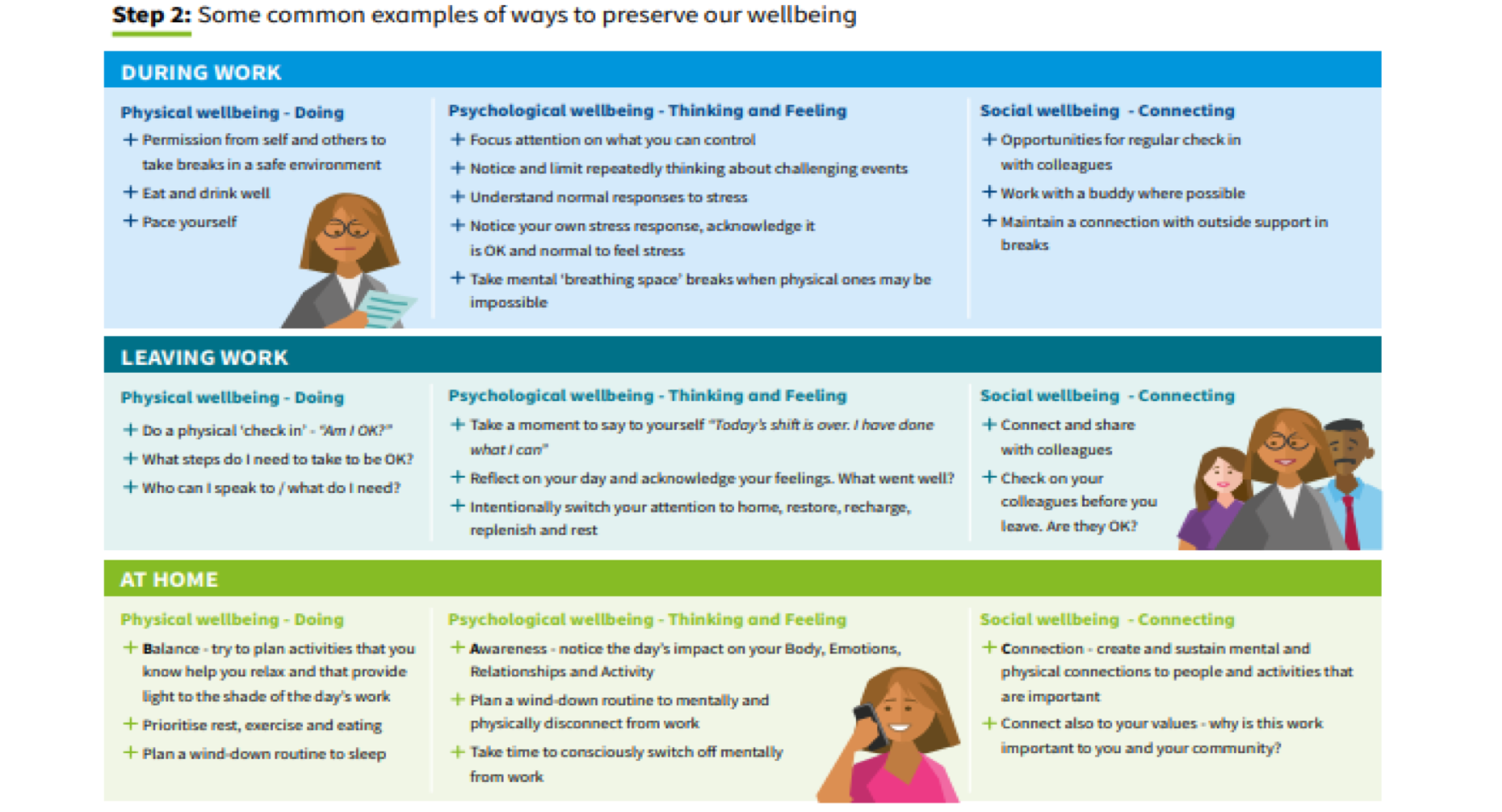Developing a staff resilience and wellbeing strategy
Supporting positive wellbeing requires a multidimensional approach, involving individual staff and team leaders, together with organisational policy, procedures and culture.
Trauma education, skills training, and supervision are key tools in the prevention of secondary traumatic stress. These elements are discussed throughout this toolkit. In this section we will focus on specific strategies for supporting staff resilience and wellbeing.
Developing a staff resiliency and wellbeing strategy should:
- Recognise the potential impact and consequences of secondary trauma on staff
- Recognise that exposure to trauma is a risk of the job of supporting survivors
- Understand that how wellbeing is managed and promoted can shape the culture of your organisation
- Understand that a staff team affected by trauma is less likely to effectively identify its clients’ past trauma or mitigate or prevent future trauma
- Provide access to additional support where required
Using this in practice will require:
- Utilising your organisation’s trauma knowledge and context and translating this into meaningful action, policy, and improvements in practice.
- Integrating the actions into direct services, programs, policies, and procedures, staff development and training, and other activities directed at secondary traumatic stress
- The policy to be part of an overall trauma informed approach to services. Safety should be embedded for survivors and staff alike.
- The policy to be reviewed on a regular basis
This overarching strategy can be supported by operational and individual actions to ensure that wellbeing is embedded across practice in the organisation. In the section below you can see some suggested approaches to embed this at an organisational, team and individual level.
Organisational operational approaches to support wellbeing:
- Provide adequate clinical supervision, including reflective supervision;
- Develop and maintain appropriate trauma caseload balance and numbers;
- Support workplace self-care groups;
- Enhance the physical safety of staff;
- Offer flexible time scheduling, recognising the need for and protecting down time;
- Create time and a physical space at work for reflection through reading, writing, meditation, among other activities;
- Ensure that support and supervision for self-employed staff is built into plans;
- Incorporate secondary trauma training and awareness into ongoing training for staff;
- Provide ongoing assessment of staff risk and resiliency;
As a trustee:
- Ensure that operational policies and procedures are in place to support staff wellbeing
- Ensure that you are active in your duty of care for staff and that their safety at work is protected
As a manager:
- Remember to lead by example to show the importance of rest and recuperation yourself, both during the working day and outside of work. There’s little point trying to encourage your team to take care of themselves if you’re not looking after yourself.
- Regularly check in with staff about how they’re coping – do not wait for them to approach you with a problem.
- Be observant for the warning signs of secondary trauma stress and act accordingly to support your team
- Encourage good wellbeing practice as part of induction processes and on an ongoing basis
- Remember that we all do different things to relax so encourage people to do what works for them.
- Make people aware of the support that is available and make it easy for them to use it.
- Build awareness and competency in the key skills of compassionate leadership.
As an individual:
- Make it a habit to check in on yourself and your wellbeing. Recognise your own warning signs and proactively support your own wellbeing.
- Prioritise rest and recuperation, both during the working day and outside of work.
- Remember that we all do different things to relax so find what works for you.
- Proactively seek support/ talk about it- (Can you help me please?’ – don’t wait for others to notice & offer help).
- Practice good boundaries/limit setting.
- See the courage, strengths in your clients AND in yourself.
- Utilise mindfulness, incl. learning to stay in the present.
- Take in the positive & work on not accumulating the negative.
- Practice spreading ‘positive’ and celebrate progress with colleagues.
Click to enlarge
Previous
How to support a colleague showing signs of secondary trauma stress
Next
Practical Wellbeing tool
